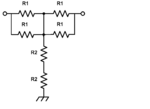Anton89
Member level 3
Hello everyone,
We are using some custom T-pad attenuators to control the signal level of a RF receiver. We have selected some 0402 SMD resistors and designed a topology where there are two pair of two parallel resistors and one pair of two series resistors (see the attachment).
We foresee to use this topology at 400 MHz and 2 GHz, therefore we would like to understand how to create a optimum layout on PCB in order to minimize the leakage between input and output, and reduce other parasitic effects.
Are there guidelines we can follow for an optimum pcb design?
Many thanks in advance.
Regards,
Antonio

We are using some custom T-pad attenuators to control the signal level of a RF receiver. We have selected some 0402 SMD resistors and designed a topology where there are two pair of two parallel resistors and one pair of two series resistors (see the attachment).
We foresee to use this topology at 400 MHz and 2 GHz, therefore we would like to understand how to create a optimum layout on PCB in order to minimize the leakage between input and output, and reduce other parasitic effects.
Are there guidelines we can follow for an optimum pcb design?
Many thanks in advance.
Regards,
Antonio
